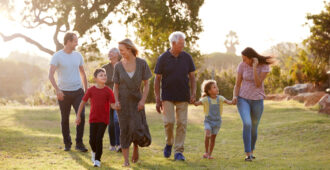
The 45 and Up Study is extremely valuable for investigating the link between risk factors and mortality outcomes in the Australian population. It has been used to estimate the association between smoking and mortality, as well as the links between mortality and risk factors such as sitting time and obesity. These findings have had a significant impact on prevention strategies and healthcare over the past decade.
The representativeness of a cohort compared to the general population can affect the accuracy of quantifying these associations. This poses a challenge for researchers: how generalisable are findings from large-scale cohorts like the 45 and Up Study, and how can researchers best address any imbalances in the data?
The Daffodil Centre, a joint venture between Cancer Council NSW and the University of Sydney, had this in mind when they put the 45 and Up Study’s cohort under the statistical microscope. A team of researchers tested the associations between 11 key characteristics – including smoking status, level of education and physical activity – and mortality outcomes.
The results, published recently in the journal Cancer Epidemiology, support the generalisability of most estimates of associations in the 45 and Up Study, particularly in relation to cancer mortality.
Lead author of the study, statistician Sarsha Yap, says that cohort studies like the 45 and Up Study need to be tested because they’re so valuable.
“Large cohort studies like the 45 and Up Study provide valuable insights to researchers when it’s not possible to conduct a randomised controlled trial or collect data from the entire population,” Yap says.
“It’s important to understand how limitations in representativeness – such as having a higher proportion of older and more educated participants, as seen in the 45 and Up Study – might affect the reliability of associations drawn from those cohorts.”
Yap and the research team looked at a mix of sociodemographic and health characteristics: baseline age; sex; educational attainment, remoteness of residence; area-level socioeconomic status; language other than English spoken at home; alcohol intake; fruit and vegetable consumption; moderate to vigorous physical activity; tobacco smoking and body mass index.
The study applied statistical weighting to the 45 and Up Study data, so the weighted cohort data matched the 2006 Australian population in seven characteristics including education and marital status. This was done to test any differences in the strength of associations between the wider range of characteristics and cancer, cardiovascular (CVD) and all-cause mortality outcomes.
Yap says that says that this research is important to global knowledge on cohort reliability and complements previous research done on the UK Biobank cohort’s representativeness.
“We set out to examine the same characteristics in the 45 and Up Study as was tested in the UK Biobank by Emmanuel Stamatakis and colleagues,” Yap explains. “We wanted to find out what happens when you weight the data.”
Weighting didn’t have a significant impact on associations drawn from the 45 and Up Study, apart from some small differences in the association between a handful of characteristics and CVD mortality. This lack of impact supports the overall generalisability of its estimates.
In comparison, weighting had a significant impact on associations drawn from the UK Biobank, showing that a lack of representativeness in the UK Biobank cohort may distort the associations between alcohol and CVD mortality, and may underestimate health hazards among those with the least healthy lifestyles.
Why the difference in impact? One theory is that the 45 and Up Study has a response rate of 19%, which is much higher than the UK Biobank’s response rate of 5%. “A higher response rate can reduce volunteer bias, so participants in cohort are more likely to represent the general population,” Yap says, noting that more research is needed to confirm this.
Yap says that the findings from her research are particularly helpful to future investigations into cancer mortality using the 45 and Up Study.
“The 45 and Up Study is a wonderful resource as it’s so rich in information and it’s the largest longitudinal study in Australia. Our study supports the generalisability of most associations investigated here.”





